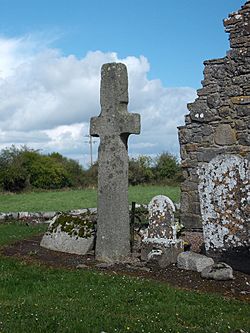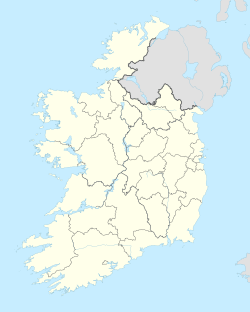Sleaty Church facts for kids
| Séipéal Shléibhte | |
 |
|
| Monastery information | |
|---|---|
| Other names | Sletty Church |
| Order | Celtic Christianity |
| Diocese | Leighlin |
| People | |
| Founder(s) | Saint Fiacc |
| Architecture | |
| Status | Inactive |
| Heritage designation | National Monument |
| Style | Irish monastic |
| Site | |
| Location | Sletty, County Laois |
| Coordinates | 52°51′29″N 6°56′30″W / 52.858035°N 6.941791°W |
| Visible remains | Ruined church, two undecorated crosses |
| Public access | yes |
Sleaty Church is an old church and a special historical site called a National Monument in County Laois, Ireland. It has a long and interesting past.
Contents
Where is Sleaty Church?
Sleaty Church is found in Ireland, about 2.5 kilometers (1.5 miles) north of Carlow town. It sits on the west side of the River Barrow.
The History of Sleaty Church
How the Monastery Began
A monastery, which is a place where monks live and worship, was started here a very long time ago. It was founded by Saint Fiacc, who lived from about 415 to 520 AD.
Legend says that Saint Fiacc first built a church called Domnach-Fiech. This was on the east side of the River Barrow. Saint Patrick, a very famous saint in Ireland, gave gifts to this church. These gifts included special clothes for ceremonies, a bell, a book of letters from Saint Paul (called the Pauline Epistles), and a crosier (a special staff carried by bishops).
Moving to a New Location
After living a strict life there for many years, Saint Fiacc was told by angels to move. They said he would find his "place of resurrection" on the west side of the Barrow. The legends also say he was guided by animals. He was told to build his oratory (a small chapel) where he saw a female red deer (a hind). He was to build his refectory (a dining hall) where he found a boar.
Saint Fiacc asked Saint Patrick for advice. Patrick then chose the spot for his new church at Slebhte, which is now known as Sletty or Sleaty.
Important People and Events
Áed of Sletty was a bishop of Sletty in the 600s. He was one of the first people to write about the life of St. Patrick. Sletty was also once a home for the King of Leinster. The last time Sletty was mentioned in history was in 1055. After this, the site became less important.
The two old crosses you can see at Sleaty are from the time of the monastery. The church building itself is from the medieval period, which came later. However, some of the very large stones used to build the church might have come from the first monastery. Using big rocks was common in early Christian buildings.
Exploring the Buildings
The Church Structure
The medieval church is mostly in ruins today. It is about 14.25 meters (46.8 feet) long and 9 meters (29.5 feet) wide. The church was built mostly with blocks of limestone. However, the east end, called the gable, was rebuilt later with sandstone. The stone doorframes, called jambs, might also be from the earlier monastery.
Today, the only parts of the church that remain are a broken window in the south gable and a doorway with a pointed top on the west side.
Near the doorway, there is an eight-sided baptismal font. This is a basin used for baptisms. It is made from rough granite and might also have been reused from the original monastery.
The Ancient Crosses
There are two granite crosses from the early monastery period. The smaller cross is to the south and is about 1.5 meters (4.9 feet) tall. It has a simple cross shape with a rough ring around it.
The taller cross is to the west and stands about 2.8 meters (9.2 feet) high. It is made from a single piece of granite and has no decorations. It has special curved shapes where the arms meet the main part of the cross.


